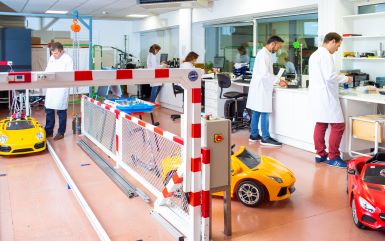Description
Target audience
Unemployed active workers, mainly in the plastics-chemical sector.
CV Faculty
Mr. Juan Luis Gámez: PhD from the Polytechnic University of Valencia (UPV), Industrial Technical Engineer, Associate Professor at the UPV teaching at the Polytechnic University of Valencia in the Department of Graphic Engineering, Head of the Technical Department in various companies, Specialist in molds and dies and polymer transformation processes, Advisor and trainer for thermoplastic injection molding companies. Translated with www.DeepL.com/Translator (free version) 20 years of experience in various companies in the plastic transformation and mold manufacturing sector.
Objectives
– Identify the safety measures related to the transformation of polymeric materials.
– Identify environmental measures related to the transformation of polymeric materials.
Content
1. Safety in the elaboration and transformation of polymers.
– Risks of handling chemicals and mixtures.
– Safe work procedures.
– Fire and explosion risk prevention. Protection and alarm systems.
– Maintenance of fire fighting equipment.
2. Prevention of environmental contamination in polymer processing industries.
– Water pollution:
• Contaminants in water (organic, inorganic, metals, heating).
• Chemical plant wastewater treatment:
° Physical-chemical treatments.
° Secondary treatments.
– Air pollution:
• Main air pollutants and emission sources.
• Airborne particles. Polluting gases (emissions and exhausts).
• Purification of atmospheric pollutants.
– Solid waste:
• Hazardous waste management and treatment.
• Characterization of hazardous waste.
– Environmental legislation and management in polymer processing industries. Environmental protection standards. Basic aspects of environmental management.
3. Risk prevention of physical, chemical and biological contaminants.
– Risks related to the work environment. Hygienic Risks. Introduction.
• Physical contaminants. Causes. Damage. Prevention.
° Noise. Vibrations. Radiation.
° The thermal environment. Thermo-hydrometric conditions.
• Chemical contaminants. Introduction. Classification according to their hazardousness.
° Regulations on classification, packaging and labeling of chemical substances.
° Labeling, safety data sheets, R-phrases and S-phrases. CLP (“Classification, Labelling and Packaging”) regulation and Globally Harmonized System (GHS) of classification and labeling of chemicals.
° Routes of entry of chemical agents into the organism.
° Chemical pollutants in the work environment: gases, vapors, dusts, fibers, fumes, mists and fogs.
° Exposure limits in Spain (INSHT). VLA.
° Detection and measurement devices. Colorimetric tubes.
° Interventions on hazardous installations (maintenance, modifications, others). Special work permits (P.T.E.)..
– Biological Contaminants Risk Prevention
– Classification of biological contaminants. Risks.
– Entrance ways.
– Preventive measures.
– Individual and collective protection measures.
Price
FREE. The training is completely free of charge as it is financed by LABORA. The Training Plan is aimed primarily at employed workers -preferably in the plastics/chemical sector- (working professionals who are registered on the first day of the course in the general Social Security system or as self-employed). Unemployed persons may also participate.
Academic entrance requirements for students
In order to take the training, students must be able to prove that they have at least one of these qualifications (Article 20, Royal Decree 34/2008, of January 18, which regulates the certificates of professionalism):
a) Hold a baccalaureate degree.
b) To be in possession of a certificate of professionalism of the same level of the training module or modules and/or of the certificate of professionalism to which the applicant wishes to gain access.
c) To be in possession of a level 2 certificate of professionalism of the same family and professional area.
d) Fulfill the academic requirement for access to higher level training cycles, or have passed the corresponding entrance exams regulated by the educational administrations.
e) To have passed the university entrance exam for those over 25 and/or 45 years of age.
f) To have the necessary key competences, in accordance with Annex IV of this Royal Decree, to successfully complete the training corresponding to the certificate of professionalism.






